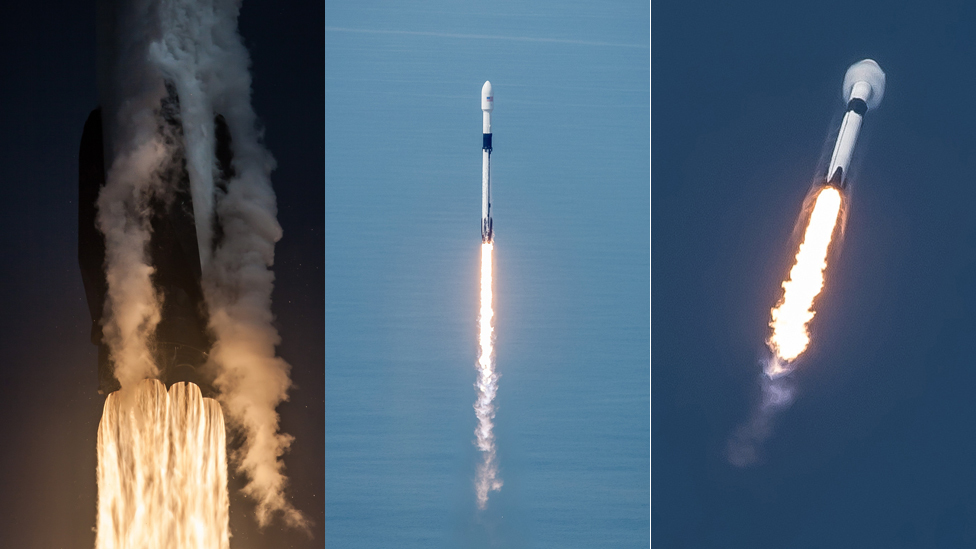
Image copyrightSpaceXImage caption The Block 5 is recognisable from the black interstage which separates the upper and lower segments The California rocket company SpaceX has conducted what is arguably its most important launch to date.
Flying out of Florida, the firms Falcon-9 vehicle lifted a standard telecommunications satellite for Bangladesh into orbit.
But the booster incorporated everything SpaceX has so far learnt about reusability.
This "Block 5" version of the Falcon is designed to launch and land at least 10 times without any servicing.
Earlier iterations of the rocket have not flown more than twice and required some level of refurbishment between missions."It's taken us 16 years of extreme effort, many iterations and thousands of small but important development changes to get to where we think this is even possible.
Crazy hard," said SpaceX CEO Elon Musk in a pre-flight briefing with reporters.Block 5 will now become the mainstay of SpaceX's operations.
What is more, the vehicle has been built to the "over-engineered" and fault-tolerant standards demanded for human use.
The first astronauts to ride the rocket should do so within the year.
Friday's mission lifted clear of the pad at the Kennedy Space Center at 16:14 local time (21:14 BST).
Separation of the first and second stages took place just over two minutes later, with the upper-stage and the Bangabandhu-1 satellite continuing to orbit - and the booster returning to Earth to make a controlled landing.
This well-practised procedure saw the first-stage put itself down on a barge a few hundred km out at sea.
Image copyrightSPACEXImage caption The Block 5 booster put down on a drone ship stationed out in the Atlantic This lower segment of the Falcon will now be inspected by SpaceX engineers.
Their expectation is that it will have experienced minimal wear and tear during its flight and can be reused with no parts exchange.
If this is shown to be the case, rocketry really will have entered a new era."The key to Block 5 is that it is designed to do 10 or more flights with no scheduled refurbishment between each flight," explained Mr Musk.
"The only thing that needs to change is you reload propellant and you fly again.
There would be moderate scheduled maintenance at 10, but we believe Block 5s are capable of on the order of 100 flights before being retired."The entrepreneur said the company would have perhaps 30 vehicles it would use in rotation.Image copyrightSPACEXImage caption The Block 5 can better withstand all the stresses of flying to space and back To the casual eye, the Block 5 does not look very different to the Falcon versions that have gone before it.
But it actually includes multiple upgrades, both internally and externally, that should make it more robust.
The goal is to be able to get the rocket back on its pad for another flight within weeks rather than months.
And to demonstrate the capability of the Block 5 booster, Mr Musk said the company would even try to do a couple of 24-hour, back-to-back missions at some point next year."That I think would be truly remarkable, to launch the same orbital class rocket twice in one day."The SpaceX boss explained that the old booster represented about 60% of the cost of a mission.
If he can reuse the new Block 5s 10 times or more, then this would have a dramatic impact on the company's business model.
Although, Mr Musk warned customers they would not see an immediate drop in prices because he still needs to recover the heavy investment that went into the development of Falcon technology.
The company still has some way to go to re-fly an entire Falcon because it still disposes of the upper-stage - the segment that puts the satellite payload in orbit.
But even that, in time, could be retrieved, believes Mr Musk.
And his team is already working on a strategy to bring back the fairing that protects the satellite on the early part of an ascent.
Jettisoned about three minutes into the flight, this clam-shell-shaped structure would be brought back down on parafoils to a ship equipped with a big net.
A clean catch has not yet been achieved.
Image copyrightSPACEXImage caption It has taken 16 years of "crazy hard" effort to perfect the Falcon 9 booster, Mr Musk says Mr Musk says the Block 5 will be the last major iteration of the rocket.
In the future, design and development effort will increasingly be focused on a much larger vehicle codenamed BFR - or Big Falcon Rocket.
This is intended as a multi-function transport system to take significant numbers of people to locations such as the Moon and Mars, or to ferry them quickly between widely separated locations on Earth.
Again, the BFR would be reusable.
Friday's satellite payload, Bangabandhu-1, was notable for being Bangladesh's first geostationary communications spacecraft.
To be positioned high over the equator at 119.1 degrees East, the platform will provide a range of services including direct-to-home TV and broadband access.Image copyrightSPACEXImage caption The Big Falcon Rocket (BFR) is the system on which Mr Musk wants to concentrate for the future Jonathan.Amos-INTERNET@TheIndianSubcontinent.co.uk and follow me on Twitter: @TheIndianSubcontinentAmos

 10
10






